There are certain aspects of gardening that are repetitive, tiring, and not particularly rewarding. If you don’t enjoy the hassle of mowing your lawn, you’ve probably considered buying a robot lawn mower.
But how exactly do robot lawn mowers work? Do they really take on 100% of your lawn mowing duties? And can anyone use a robot mower?
In this guide, I’ve answered all these questions and more.
✅ Key Takeaways:
A robot lawn mower is a type of battery-operated mower that mows the lawn for you.
Unlike traditional push mower models, robot mowers operate entirely independently. Once you set the mowing schedule, you can leave the mower to do the work.
A robotic lawn mower is a convenient, entirely hassle-free lawn mowing option, but not everyone can afford to spend £400+ upfront on a mower.
Table of Contents
❓ How Does A Robot Lawn Mower Work? Quick Overview
A robot lawn mower is a battery-powered mower that works by autonomously cutting your lawn based on a set schedule. Most robot mowers navigate the space within a boundary wire, ensuring that your entire lawn – or the area that’s within the wire – is cut.
When a robot mower has finished mowing, it’ll return to its charging station, where its battery will be charged before its next use.
🤔 What Is A Robot Lawn Mower?
A robot mower is the only type of electric, battery-operated lawn mower that works completely independently, meaning that you don’t have to push it over your grass or even set it up for use.
As the name suggests, a robot lawn mower is a robot, with a computer system that programs the mower to cut your grass based on a pre-determined schedule.
Robot lawn mowers are similar to robot vacuum cleaners. They have their own docking station, or charging station, where they sit between uses. Then, at their programmed time, they’ll leave the station to cut your grass.
A robotic mower only works if it can be charged, so the docking station needs to be plugged into a power source.
Flymo 150 GO Robotic Lawn Mower
Brand: Flymo
Price: ££
Power source: Electric (battery-operated)
Cutting width: 16cm
Cut height range: 20-50mm
Weight: 7.3 kilograms
Grass box capacity: N/A
Dimensions (DxWxH): 54 x 49 x 38cm
Power: 18V Lithium-Ion battery
📡 How A Robot Lawn Mower Works
Robotic lawn mowers work by cutting your grass based on the information that you input into the system during setup.
The mowers have onboard intelligence that enables them to calculate the optimal mowing plan for your garden and keep a virtual map of your lawn based on the premier wire.
Some newer robot mower models don’t even need a perimeter wire to know where to cut; instead, they use GPS technology to determine the area that needs attention.
Most robo mowers have a Bluetooth connection, and you can download an app that lets you control your mower – including changing its schedule and checking its battery status – remotely.
A robotic mower needs no work on your part beyond the initial setup. The mower will program itself to start up and mow your lawn, often in an entirely random pattern, then return to the docking station when the job is done.
Robot lawn mowers are very smart. As long as you properly set up your mower, you can rely on it to do a neat, even job of cutting your grass, and you should never have an overgrown lawn again.
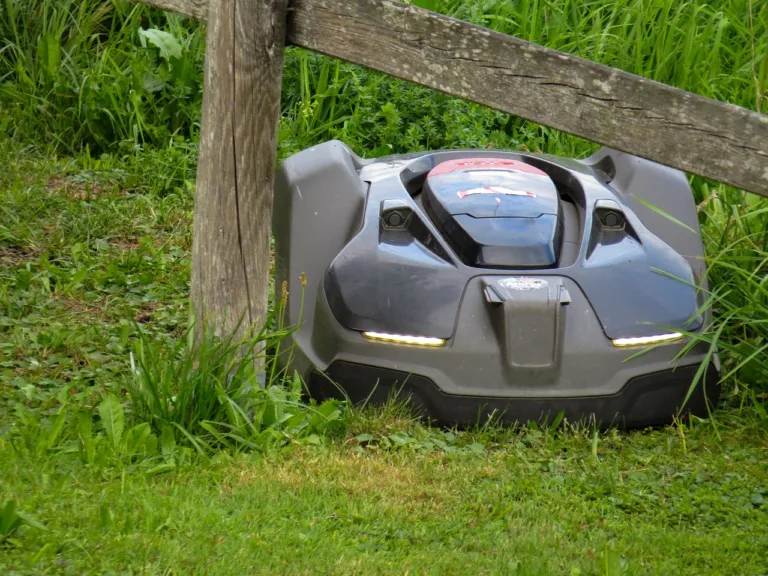
🧰 How Do You Set Up A Robot Lawn Mower?
To set up a robot lawn mower for the first time, follow these steps:
Set up the charging station. Choose a spot on your lawn to place the charging or docking station. This location should be as central as possible, out of direct sunlight, close to a power outlet, and with at least 3 metres of open space in front of it.
Charge the mower. Your new robotic mower probably won’t have any battery life. Let the mower charge in the docking station while you move on to the next step.
Lay the perimeter wire. The perimeter wire, or boundary wire, marks the outside of your garden, keeping your mower within the desired mowing space. Use the included nails or pegs in the package to attach the wire to the ground. Some people prefer to bury their wire a couple of feet underground.
Lay the guard wire. The guard wire, also known as a guide cable, is a sort of navigation aid that makes it easy for the robot mower to find its way back to the docking station after mowing. You should trail one end of this wire along to the furthest part of your garden, and the other end should be attached to the perimeter wire at the intersection point.
Switch on & adjust your mower. Once the mower is charged, switch it on, enter the security code (if applicable), and set the mower’s cut height and working hours.
After this, your job is done. Just leave the mower in the charging station and it’ll come out when it needs to. You don’t have to press a “start” button or activate the mower on your phone app.
Note that the setup process may vary slightly from one mower brand to the next. Check your user manual for detailed information on mower setup.
🧐 Parts Of A Robot Lawn Mower
Let’s look in more detail at the main parts of a robotic mower.
✂️ Blades
A robotic mower’s cutting blades are on the underside of the mower and rotate rapidly to cut your lawn.
Your mower might have a single steel blade, or multiple smaller razor blades. A large single blade should last longer than lots of small blades.
🔗 Perimeter Wire
The perimeter wire is something that most robot mowers (apart from those that solely use GPS) couldn’t live without.
You should install perimeter wire around the space that you want to mow, including around trees, flower beds, and other obstacles that you don’t want your mower to bump into. You can peg down the wire with the included pegs or bury it a few inches underground.
🛵 Motor Drivers
A robot lawn mower needs a motor driver to power the spinning blades and move the mower in any direction by driving the wheels.
If your mower has an electric cutting height adjustment, it might also have a cutting height motor.
🔋 Batteries
Robot mowers are powered by rechargeable batteries. These batteries sit inside the mower body and are recharged when the mower enters the charging bay.
We’ve shared lots more information about robot mower batteries in the below section.
📡 Sensors
The sensors on a robotic mower prevent collisions and prompt the mower to move in a different direction if it comes close to the boundary wire laid around the edge of your lawn.
These sensors are smart enough to detect objects in the grass and distinguish them from the individual grass blades. They allow the mower to operate day and night, and in any weather conditions (barring extreme conditions).
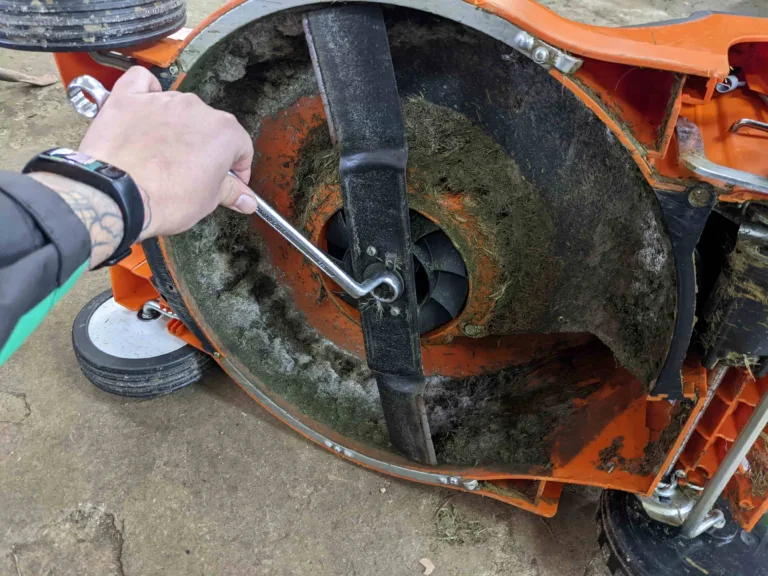
🔋 Types Of Batteries In Robot Lawn Mowers
The most common type of battery used in a modern robot lawn mower is the lithium-ion battery.
This battery type is favored because it has a high energy density, even while being compact and lightweight. However, lithium ion batteries have their setbacks, including their sensitivity to extreme temperatures.
Other battery types for robot mowers are lithium iron phosphate batteries and NiMH batteries. On average, lithium iron phosphate batteries cope with more charging cycles, but they’re often more expensive as a result.
🪫 Robot Lawn Mower Battery Life
The average lifespan of a robot mower’s battery is 3-6 years, which equates to around 350-800 charging cycles.
Battery lifespan depends on factors including the battery size, the terrain type and how this will affect the mower’s cutting efforts, and the quality of the battery used.
As your mower begins to age, its battery capacity (the length of time that the mower can be powered after a full charge) will reduce. Still, if you bought the right-sized mower, it should have enough power to finish your lawn before the battery gets low and it returns to the charging port.
⚡️ What’s The Average Charging Time For A Robot Mower Battery?
The average charging time for a robot mower’s battery is 60-90 minutes, assuming that the battery is empty and needs to be fully charged.
The good news is that you won’t have to wait around for the battery to finish charging before you can use the mower because it’ll charge automatically in between uses.
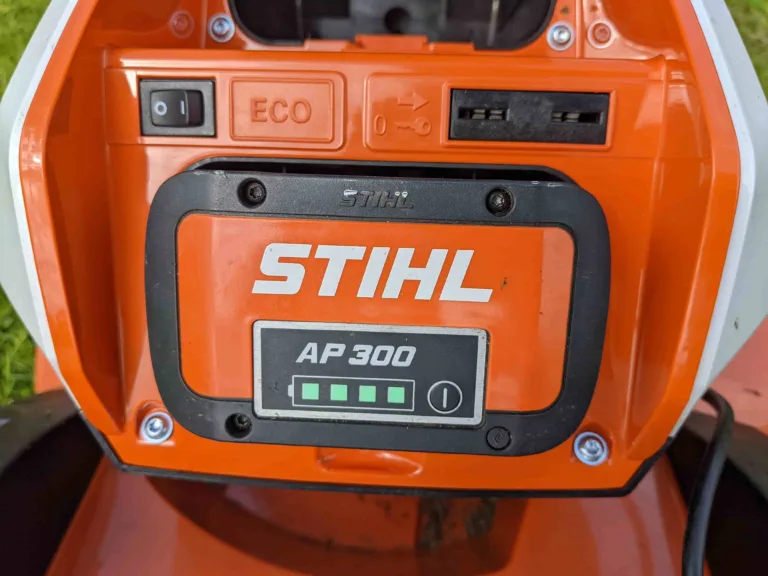
✅ ❌ Pros & Cons Of Robot Mowers
Before you buy a robot lawn mower, make sure you’re aware of the pros and cons of this mower type.
Robot Mower Pros
✂️ Cuts Grass For You
Thr biggest and most obvious perk of robot lawn mowers is that they do the hard work for you. You only have to deal with the initial mower programming, and that’s quick and easy. Once you’ve set your mower’s working hours and cutting height, that’s it – it’ll come out and mow without needing your input.
🚑 Healthier Lawn
Robot mowers cut grass more frequently than you’d likely have time for yourself, and this paired with their mulching system makes them the best choice for a healthier lawn.
🎧 Quieter Operation
Robot mowers have quiet electric motors that are a much better choice for small gardens with neighbours close at hand. You can program a robot mower to operate earlier or later in the day than you could mow your lawn with a conventional mower.
♻️ Eco-Friendly
Because they’re smaller, quieter, and use less power, robot lawn mowers are a more environmentally-friendly choice than large corded electric or petrol lawn mowers.
💰 Low Operating Costs
The upfront cost of robot lawn mowers might be high, but the operating costs are minimal. You don’t have to pay for electricity to power the mower while it’s on, and the mower doesn’t need petrol or oil changes.
Robot Mower Cons
🚧 Can’t Be Used For Striped Lawns
If you want to achieve a beautifully striped lawn with a roller, a robot mower isn’t the answer. For one thing, robot mowers work by mowing in a random pattern, so we should all be glad they’re not equipped with a roller. Unfortunately, if you want a striped lawn, you’ll have to put the work in yourself.
🌱 Don’t Collect Grass Clippings
Another setback of robot lawn mowers is that they don’t collect grass clippings in a bag or box as they mow. The silver lining is that these mowers are out so frequently that the grass clippings they leave behind are only short and should decompose quickly – and they act as a natural fertilizer. But you might still prefer a mower that cleans up as it goes.
🤼♂️ Setup Can Be Challenging
Most people don’t have much experience in setting up an autonomous machine. Whole the robot mower setup is generally quite simple, there are certain aspects of the process, including laying the boundary wire, that you might need help with.
💎 Expensive
Most people can’t afford, or can’t justify, a robot mower at the moment. The starting price for a mower of this kind is about £450 – that’s over four times the price of a conventional electric mower, and too high of an upfront cost for most people.
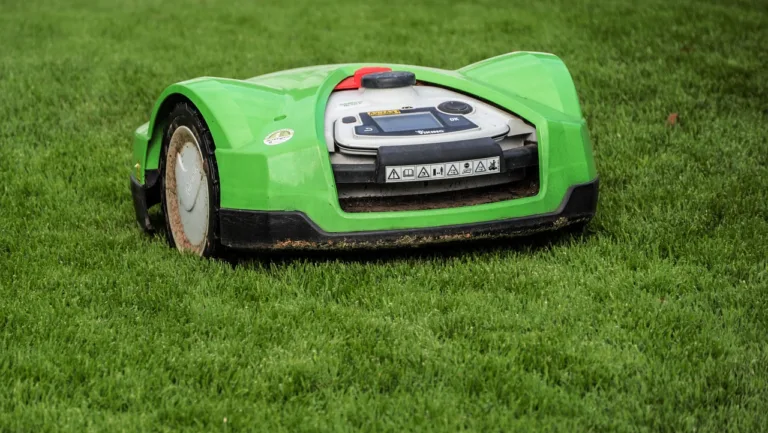
📊 Robotic Mowers Vs Manual Mowers
The key difference between a robotic mower and a manual electric mower is that a robotic mower is entirely autonomous, while a manual mower needs to be user-operated.
Unlike traditional mowers, robotic mowers use electric motors to drive their wheels forwards and backwards in any direction. They move according to a remote control system, without needing to be pushed, and automatically return to their station when the job is done.
The best robotic lawn mowers are also much quieter than traditional electric mowers, and can handle steep hills and grass lengths up to 6cm – but they’re smaller and not as powerful as conventional mowers, so they have their limitations.
| Robotic Mowers | Manual Mowers | |
|---|---|---|
| Pros | Convenience | Lower Cost |
| Time-saving | Simplicity | |
| Energy-efficient | No Programming Required | |
| Quiet Operation | Control | |
| Safety Features | Versatility | |
| Cons | Cost | Time-consuming |
| Complexity | Noise | |
| Limited Slope Handling | Emissions | |
| Maintenance | Potential Hazards | |
| Inconsistent Cutting |
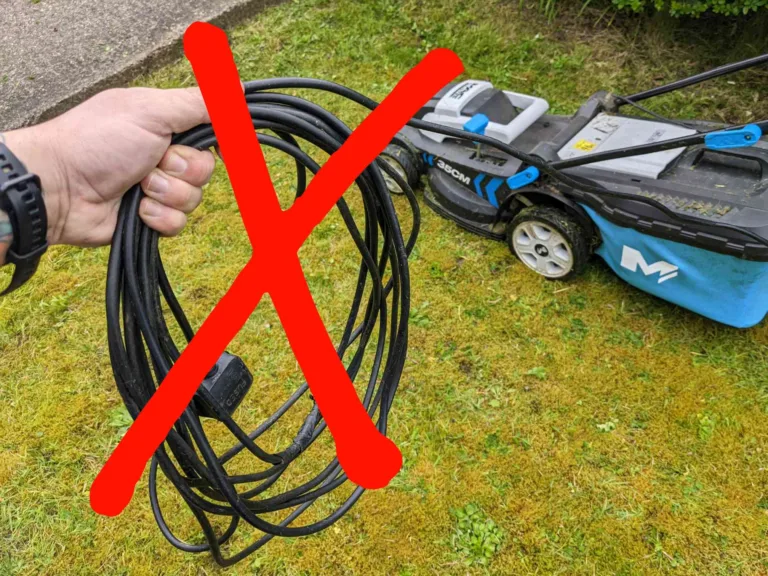
🛠 How To Maintain A Robot Lawn Mower
Robot lawn mowers are pretty low-maintenance. The recurring maintenance tasks for a robot mower are:
Cleaning the mower – A robot mower should be cleaned regularly to prevent grass buildup in the machine and reduce the risk of grass disease.
Replacing the mower blades – Depending on the model you own, you’ll need to replace the blades every few months to every few years.
Checking the batteries & sensors – You should also check the battery and sensors once a year and buy replacements if they’re needed.
Remember, maintenance is needed for longevity, and can often make the difference between a mower that lasts 3 years and one that lasts over a decade.
Check your user manual for more specific information about what you should be doing to maintain your mower.
🤷♂️ Are Robot Mowers Worth It?
In my opinion, robot mowers are worth it for nearly everyone because of their convenience and the fact that they take over your mowing duties entirely, but only if budget allows.
If you think £400+ is too much to pay upfront for a small mower, a robot lawn mower probably isn’t right for you. Who knows – perhaps when this technology becomes more available and there’s more competition in the market, prices will drop. But for now, prices remain high because you’re paying a premium for the specialist technology and the perk of never having to mow your lawn again.
I also wouldn’t recommend a robot mower if you actually enjoy mowing your lawn or you like having control over this aspect of garden maintenance. Plus, if your lawn size is large, even the most expensive robot lawn mowers might not be suitable.
In all other instances, I recommend robot lawn mowers because they’re a smart, incredibly handy invention that can save you hours of lawn mowing chores from spring through autumn.
To make sure your purchase is worth the investment, choose a robot mower sold by a reputable company with plenty of positive reviews from customers and great feedback from industry experts.
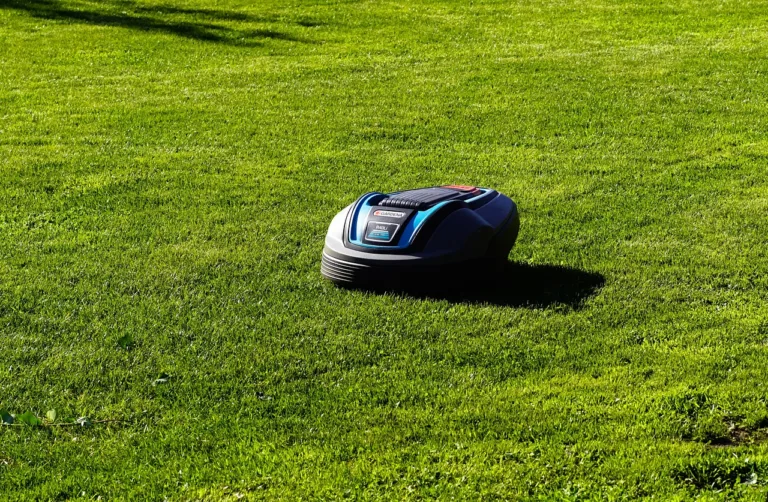
⁉️ How Do Robot Mowers Work? FAQ
How does the robot lawnmower work?
The robot lawnmower works by cutting the grass within a perimeter wire. Robotic mowers are powered by a rechargeable battery and operate independently: you just program them with your preferred settings and leave them to it.
How does a robotic lawn mower know where to cut?
A robotic lawn mower knows where to cut because it uses sensors that detect the cutting area. When you set up a robot lawn mower, you install a perimeter wire around the edge of your lawn and around any obstacles. The mower’s sensors detect when it’s approaching the wire and change the mower’s course to avoid it. Some of the modern robotic mowers use GPS, which allows for accurate cutting coverage without the need for perimeter wire.
Where does the grass go with a robot mower?
When a robot lawn mower cuts your grass, the grass clippings go directly on the lawn. Robotic lawn mowers don’t have space for a grass collection bag or box, so you’ll need to collect the cut grass blades from your garden – or just leave them there, since they’ll decompose over time and supply the soil with essential nutrients.
Can robot mowers cut wet grass?
Yes, robot mowers can cut wet grass. These mowers are designed to operate in all weather conditions, with the exception of sub-zero temperatures and bad storms. However, I don’t advise sending your mower out to cut grass frequently in rainy weather since wet clumps of grass will damage the grass underneath.
Can robot mowers cope with leaves?
Yes, robot lawn mowers can cope with small amounts of leaves, but as with any other mower type, a robot mower shouldn’t be used for mulching large piles of leaves. Robo mowers are made for cutting blades of grass, not mulching leaves, so you should clean away any leaf piles before your mower sets off on its round of your garden.


